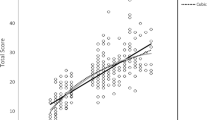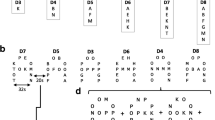Abstract
Verbal and spatial working memory were examined in high-functioning children, adolescents, and adults with autism compared to age and cognitive-matched controls. No deficit was found in verbal working memory in the individuals with autism using an N-back letter task and standardized measures. The distinction between the N-back task and others used previously to infer a working memory deficit in autism is that this task does not involve a complex cognitive demand. Deficits were found in spatial working memory. Understanding the basis for the dissociation between intact verbal working memory and impaired spatial working memory and the breakdown that occurs in verbal working memory as information processing demands are increased will likely provide valuable insights into the neural basis of autism.
Similar content being viewed by others
References
Baddeley A., (1986). Working memory New York: Oxford University Press
Baddeley A., (1992). Is working memory working? Quarterly Journal of Experimental Psychology: Human Experimental Psychology 44A(1): 1–31
Bauman M. L., Kemper T. L., (1990). Limbic and cerebellar abnormalities are also present in an autistic child of normal intelligence Neurology 40: 359
Bauman M. L., Kemper T. L., (1994). Neuroanatomic observations of the brain in autism. In Bauman M. L., Kemper T. L., (Eds), The neurobiology of autism. Baltimore: Johns Hopkins University Press. pp. 119–145
Bennetto L., Pennington B. F., Rogers S. J., (1996). Intact and impaired memory function in autism Child Development 67: 1816–1835
Courchesne E., Karns C. M., Davis H. R., Ziccardi R., Carper R. A., Tigue Z. D., Chisum H. J., Moses P., Pierce K., Lord C., Lincoln A. J., Pizzo S., Schreibman L., Haas R. H., Akshoomoff N. A., Courchesne R. Y., (2001). Unusual brain growth patterns in early life in patients with autistic disorder: An MRI study Neurology 57: 245–254
Frith U., (1989). Autism: Explaining the enigma. Oxford: Blackwell
Frith U., Happé F., (1994). Autism: Beyond ‘theory of mind’Cognition 50: 115–132
Goldberg M. C., Lasker A. G., Zee D. S., Garth E., Tien A., Landa R. J., (2002). Deficits in the initiation of eye movements in the absence of a visual target in adolescents with high functioning autism Neuropsychologia 40: 2039–2049
Gruber O., von Cramon D. Y., (2003). The functional neuroanatomy of human working memory revisited: Evidence from 3-T fMRI studies using classical domain-specific interference tasks NeuroImage 19: 797–809
Heaton R. K., Chelune G., Talley J., Talley J. L., Kay G. G., Curtiss G., (1993). Wisconsin card sorting test manual: Revised and expanded. Odessa FL: Psychological Assessment Resources
Hermelin B., O’Connor N., (1970). Psychological experiments with autistic children New York: Pergamon Press
Hughes C., Russell J., Robbins T. W., (1994). Evidence for executive dysfunction in autism Neuropsychologia 32: 477–492
Just M. A., Carpenter P. A., (1992) A capacity theory of comprehension: Individual differences in working memory Psychological Review 99: 122–149
Just, M. A., Cherkassky, V. L., Keller, T. A., & Minshew, N. J. (2004). Cortical activation and synchronization during sentence comprehension in high-functioning autism: Evidence of underconnectivity. Brain 127: 1811–1821
Kimberg D. Y., Farah M. J., (1993). A unified account of cognitive impairments following frontal lobe damage: The role of working memory in complex, organized behavior Journal of Experimental Psychology, General 122: 411–428
Kaufman A. S., Kaufman N. L., (1985). Kaufman test of educational achievement Circle Pines, MN: American Guidance Services
Koczat D. L., Rogers S. J., Pennington B. F., Ross R. G., (2002). Eye movement abnormality suggestive of a spatial working memory deficit is present in parents of autistic probandsJournal of Autism and Developmental Disorders 32: 513–519
Kojima S., Goldman-Rakic P. S., (1982). Delay-related activity of prefrontal neurons in rhesus monkeys performing delayed response Brain Research 248: 43–50
Le Couteur A., Rutter M., Lord C., Rios P., Robertson S., Holdgrafer M., McLennan J., (1989). Autism Diagnostic Interview: A standardized investigator-based instrument Journal of Autism and Developmental Disorders 19: 363–387
Levy R., Goldman-Rakic P. S., (2000). Segregation of working memory functions within the dorsolateral prefrontal cortex Experimental Brain Research 133: 23–32
Lord C., Rutter M., Goode S., Heemsbergen J., Jordan H., Mawhood L., Schopler E., (1989) Autism Diagnostic Observation Schedule: A standardized observation of communicative and social behavior Journal of Autism and Developmental Disorders 19: 185–212
Lord C., Rutter M., Le Couteur A., (1994) Autism Diagnostic Interview-Revised: A revised version of a diagnostic interview for caregivers of individuals with possible pervasive developmental disordersJournal of Autism and Developmental Disorders 24: 659–685
Lord C., Rutter M., DiLavore P. C., Risi S., (1999) Autism diagnostic observation schedule (ADOS). Los Angeles: Western Psychological Services
Luna B., Minshew N. J., Garver K. E., Lazar N. A., Thulborn K. R., Eddy W. F., Sweeney J. A., (2002). Neocortical system abnormalities in autism: An fMRI Study of spatial working memory Neurology 59: 834–840
Minshew N. J., Goldstein G., (2001). The pattern of intact and impaired memory functions in autism Journal of Child Psychology and Psychiatry 42: 1095–1101
Minshew N. J., Goldstein G., Siegel D. J. (1995). Speech and language in high-functioning autistic individuals Neuropsychology 9: 255–261
Minshew N. J., Goldstein G., Siegel D. J., (1997). Neuropsychologic functioning in autism: Profile of a complex information processing disorder Journal of the International Neuropsychological Society 3: 303–316
Minshew N. J., Luna B., Sweeney J. A., (1999). Oculomotor evidence for neocortical systems but not cerebellar dysfunction in autism Neurology 52: 917–922
Minshew N. J., Meyer J., Goldstein G., (2002). Abstract reasoning in autism: A dissociation between concept formation and concept identification Neuropsychology 16: 327–334
Minshew N. J., Sweeney J. A., Luna B., (2002). Autism as a selective disorder of complex information processing and underdevelopment of neocortical systems Molecular Psychiatry 7: S14–S15
Ozonoff S., Jensen J., (1999). Specific executive function profiles in three neurodevelopmental disorders Journal of Autism and Developmental Disorders 29: 171–177
Ozonoff S., McEvoy R. E., (1994). A longitudinal study of executive function and theory of mind development in autism Development and Psychopathology 6: 415–431
Ozonoff S., Pennington B. F., Rogers S. J., (1991). Executive function deficits in high-functioning autistic individuals: Relationship to theory of mind Journal of Child Psychology and Psychiatry 32: 1081–1105
Ozonoff S., Strayer D. L., (2001). Further evidence of intact working memory in autism Journal of Autism and Developmental Disorders 31: 257–263
Pennington B. F., (1994). The working memory function of the pre-frontal cortices: Implications for developmental and individuals differences in cognition. In: Haith M. M., Benson J. B., Roberts R. J., Pennington B. F., (Eds), The development of future-oriented processes. Chicago: University of Chicago Press
Piven J., Arndt S., Bailey J., Havercamp S., Andreasen N. C., Palmer P., (1995). An MRI study of brain size in autism American Journal of Psychiatry 152: 1145–1149
Rumsey J. M., Hamburger S. D., (1988) Neuropsychological findings in high-functioning men with infantile autism, residual state Journal of Clinical and Experimental Neuropsychology 10: 201–221
Russell J., Jarrold C., Henry L., (1996). Working memory in children with autism and moderate learning difficulties Journal of Child Psychology and Psychiatry 37: 673–686
Shallice T., (1982). Specific impairments in planning. In: Broadbent D. E., Weiskrantz L., (Eds), The neuropsychology of cognitive function. London: Royal Society pp. 199–209
Sheslow D., Adams W., (1990). WRAML: Wide range assessment of memory and learning. Wilmington, DE: Jastak Assessment Systems
Smith E. E., Jonides J., (1999). Storage and executive processes in the frontal lobes Science 283: 1657–1661
Smith E. E., Jonides J., (1998). Neuroimaging analyses of human working memory Proceedings of the National Academy of Sciences 95: 12061–12068
Szatmari P., MacLean J. E., Jones M. B., Bryson S. E., Zwaigenbaum L., Bartolucci G., Mahoney W. J., Tuft L., (2000). The familial aggregation of the lesser variant in biological and nonbiological relatives of PDD probands: A family history study Journal of Child Psychology and Psychiatry 41: 579–586
Wechsler D., (1991). Wechsler intelligence scale for children 3. San Antonio, TX: The Psychological Corporation
Wechsler D., (1997a). Wechsler adult intelligence scale 3. San Antonio, TX: The Psychological Corporation
Wechsler D., (1997b). Wechsler Memory Scale-III: Administration and scoring manual. San Antonio, TX: The Psychological Corporation
Williams, D. L., Goldstein, G., & Minshew, N. J. (2004). A further characterization of complex cognitive abilities in high functioning autism. Manuscript submitted for publication
ACKNOWLEDGMENTS
The National Institute of Child Health and Human Development Grant HD35469 to Nancy J. Minshew supported this research. This study was supported by an NICHD Collaborative Program of Excellence in Autism (CPEA). The Medical Research Service, Department of Veterans Affairs is also acknowledged for support of this research. Diane L. Williams was supported by National Institute of Mental Health Grant T32-MH18951.
Author information
Authors and Affiliations
Corresponding author
Rights and permissions
About this article
Cite this article
Williams, D.L., Goldstein, G., Carpenter, P.A. et al. Verbal and Spatial Working Memory in Autism. J Autism Dev Disord 35, 747–756 (2005). https://doi.org/10.1007/s10803-005-0021-x
Published:
Issue Date:
DOI: https://doi.org/10.1007/s10803-005-0021-x




